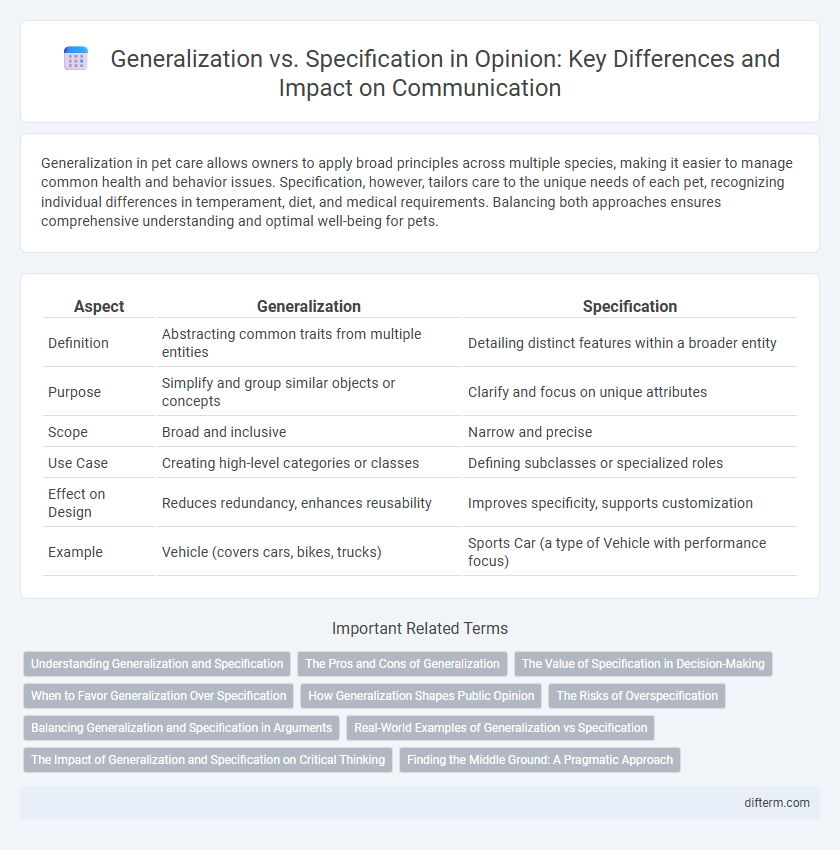Generalization in pet care allows owners to apply broad principles across multiple species, making it easier to manage common health and behavior issues. Specification, however, tailors care to the unique needs of each pet, recognizing individual differences in temperament, diet, and medical requirements. Balancing both approaches ensures comprehensive understanding and optimal well-being for pets.
Table of Comparison
| Aspect | Generalization | Specification |
|---|---|---|
| Definition | Abstracting common traits from multiple entities | Detailing distinct features within a broader entity |
| Purpose | Simplify and group similar objects or concepts | Clarify and focus on unique attributes |
| Scope | Broad and inclusive | Narrow and precise |
| Use Case | Creating high-level categories or classes | Defining subclasses or specialized roles |
| Effect on Design | Reduces redundancy, enhances reusability | Improves specificity, supports customization |
| Example | Vehicle (covers cars, bikes, trucks) | Sports Car (a type of Vehicle with performance focus) |
Understanding Generalization and Specification
Understanding generalization involves recognizing broad patterns and commonalities across diverse instances, enabling efficient problem-solving and knowledge transfer. In contrast, specification requires attention to detailed, context-specific attributes that ensure precision and relevance in particular scenarios. Balancing these approaches enhances decision-making by combining comprehensive insight with targeted accuracy.
The Pros and Cons of Generalization
Generalization offers the advantage of versatility, enabling individuals to adapt skills across a wide range of fields and situations, which enhances problem-solving flexibility. However, it often comes at the expense of deep expertise, potentially leading to superficial knowledge and less competitive advantage in specialized domains. Balancing generalization with targeted skill development is crucial for maximizing both adaptability and proficiency.
The Value of Specification in Decision-Making
Specification sharpens decision-making by enabling targeted analysis of relevant data, reducing ambiguity and improving outcome accuracy. It helps identify critical variables and tailor strategies to specific contexts, thereby enhancing operational efficiency and effectiveness. Focusing on precise details empowers decision-makers to assess risks and opportunities more reliably than broad generalizations.
When to Favor Generalization Over Specification
Favor generalization over specification when addressing diverse user needs or unpredictable environments, as it enhances flexibility and scalability. Systems designed with generalization can adapt more easily to new tasks or data without extensive reengineering. Emphasizing broad applicability reduces the risk of obsolescence in rapidly evolving domains like software development or machine learning.
How Generalization Shapes Public Opinion
Generalization simplifies complex issues, making it easier for the public to form quick judgments and shared perspectives. It often leads to the reinforcement of stereotypes and broad assumptions, which can influence voting behaviors and social attitudes. However, its impact on public opinion depends on how accurately these generalizations reflect the nuanced reality of specific situations.
The Risks of Overspecification
Overspecification in any context narrows the scope and limits flexibility, leading to missed opportunities and stifled creativity. It risks alienating diverse audiences or users by imposing overly rigid criteria that fail to accommodate exceptions or evolving needs. Emphasizing broad applicability over narrow precision often results in more adaptable and resilient outcomes.
Balancing Generalization and Specification in Arguments
Balancing generalization and specification in arguments enhances clarity and persuasiveness by addressing both broad principles and concrete details. Effective arguments leverage generalization to establish overarching frameworks while employing specification to provide relevant evidence that supports those frameworks. This balance avoids vague assertions and overly narrow claims, fostering a nuanced understanding that resonates with diverse audiences.
Real-World Examples of Generalization vs Specification
Generalization allows businesses to appeal to a broad audience, as seen with brands like Amazon offering diverse products to meet various needs. In contrast, specification targets niche markets effectively, exemplified by Tesla's focus on high-performance electric vehicles catering to eco-conscious consumers. These real-world examples demonstrate how generalization drives volume while specification fosters brand loyalty through tailored experiences.
The Impact of Generalization and Specification on Critical Thinking
Generalization enables broad understanding by identifying common patterns, which facilitates efficient decision-making but can oversimplify complex issues, leading to biased conclusions. Specification demands attention to detail and context, promoting deeper analysis and nuanced reasoning that strengthens critical thinking skills. Balancing generalization and specification is essential for enhancing critical thinking, as it allows for both comprehensive perspectives and precise evaluations.
Finding the Middle Ground: A Pragmatic Approach
Finding the middle ground between generalization and specification ensures balanced decision-making that leverages broad insights while addressing specific needs. This pragmatic approach maximizes efficiency by avoiding both the pitfalls of overly vague conclusions and the limitations of narrow perspectives. Emphasizing adaptability, it supports nuanced understanding in complex contexts, enhancing problem-solving and strategic planning.
generalization vs specification Infographic

 difterm.com
difterm.com